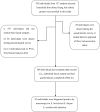Prevalence and risk factors associated with Entamoeba histolytica/dispar/moshkovskii infection among three Orang Asli ethnic groups in Malaysia
- PMID: 23133561
- PMCID: PMC3485054
- DOI: 10.1371/journal.pone.0048165
Prevalence and risk factors associated with Entamoeba histolytica/dispar/moshkovskii infection among three Orang Asli ethnic groups in Malaysia
Abstract
Background: Entamoeba histolytica/Entamoeba dispar/Entamoeba moshkovskii infection is still prevalent in rural Malaysia especially among Orang Asli communities. Currently, information on prevalence of this infection among different ethnic groups of Orang Asli is unavailable in Malaysia. To contribute to a better comprehension of the epidemiology of this infection, a cross-sectional study aimed at providing the first documented data on the prevalence and risk factors associated with E. histolytica/E. dispar/E. moshkovskii infection was carried out among three Orang Asli ethnic groups (Proto-Malay, Negrito, and Senoi) in selected villages in Negeri Sembilan, Perak, and Pahang states, Malaysia.
Methods/findings: Faecal samples were examined by formalin-ether sedimentation and trichrome staining techniques. Of 500 individuals, 8.7% (13/150) of Proto-Malay, 29.5% (41/139) of Negrito, and 18.5% (39/211) of Senoi were positive for E. histolytica/E. dispar/E. moshkovskii, respectively. The prevalence of this infection showed an age-dependency relationship, with higher rates observed among those aged less than 15 years in all ethnic groups studied. Multivariate analysis confirmed that not washing hands after playing with soils or gardening and presence of other family members infected with E. histolytica/E. dispar/E. moshkovskii were significant risk factors of infection among all ethnic groups. However, eating with hands, the consumption of raw vegetables, and close contact with domestic animals were identified as significant risk factors in Senoi.
Conclusions: Essentially, the findings highlighted that E. histolytica/E. dispar/E. moshkovskii parasites are still prevalent in Malaysia. Further studies using molecular approaches to distinguish the morphologically identical species of pathogenic, E. histolytica from the non-pathogenic, E. dispar and E. moshkovskii are needed. The establishment of such data will be beneficial for the public health authorities in the planning and implementation of specific prevention and control strategies of this infection in different Orang Asli ethnic groups in Malaysia.
Conflict of interest statement
Figures
Similar articles
-
Molecular epidemiology of amoebiasis in Malaysia: highlighting the different risk factors of Entamoeba histolytica and Entamoeba dispar infections among Orang Asli communities.Int J Parasitol. 2012 Dec;42(13-14):1165-75. doi: 10.1016/j.ijpara.2012.10.003. Epub 2012 Oct 30. Int J Parasitol. 2012. PMID: 23123168
-
Assessing the prevalence and risk factors associated with Entamoeba complex infection among the Orang Asli school children in Perak, Malaysia through molecular approach.Parasitol Int. 2022 Dec;91:102638. doi: 10.1016/j.parint.2022.102638. Epub 2022 Aug 1. Parasitol Int. 2022. PMID: 35926695
-
First molecular identification of Entamoeba moshkovskii in Malaysia.Parasitology. 2012 Oct;139(12):1521-5. doi: 10.1017/S0031182012001485. Epub 2012 Sep 3. Parasitology. 2012. PMID: 22939193
-
Public health and clinical importance of amoebiasis in Malaysia: a review.Trop Biomed. 2011 Aug;28(2):194-222. Trop Biomed. 2011. PMID: 22041740 Review.
-
Entamoeba moshkovskii perspectives of a new agent to be considered in the diagnosis of amebiasis.Acta Trop. 2012 Sep;123(3):139-45. doi: 10.1016/j.actatropica.2012.05.012. Epub 2012 Jun 2. Acta Trop. 2012. PMID: 22664420 Review.
Cited by
-
Prevalence of Entamoeba histolytica, Giardia lamblia, and Cryptosporidium spp. in Libya: 2000-2015.Libyan J Med. 2016 Jun 29;11:32088. doi: 10.3402/ljm.v11.32088. eCollection 2016. Libyan J Med. 2016. PMID: 27363524 Free PMC article. Review.
-
The epidemiology of amoebiasis in Thi-Qar Province, Iraq (2015-2020): differentiation of Entamoeba histolytica and Entamoeba dispar using nested and real-time polymerase chain reaction.Epidemiol Health. 2021;43:e2021034. doi: 10.4178/epih.e2021034. Epub 2021 May 6. Epidemiol Health. 2021. PMID: 33971701 Free PMC article.
-
Intestinal parasitic infections and determinant factors among school-age children in Ethiopia: a cross-sectional study.BMC Res Notes. 2019 Nov 28;12(1):777. doi: 10.1186/s13104-019-4759-1. BMC Res Notes. 2019. PMID: 31779671 Free PMC article.
-
Prevalence and associated risk factors of Giardia infection among indigenous communities in rural Malaysia.Sci Rep. 2014 Nov 4;4:6909. doi: 10.1038/srep06909. Sci Rep. 2014. PMID: 25366301 Free PMC article.
-
Entamoeba sp. in a city in the Amazon interior in Brazil: Microscopic parasitological, immunological, and molecular diagnosis.Parasite Epidemiol Control. 2025 Apr 25;29:e00424. doi: 10.1016/j.parepi.2025.e00424. eCollection 2025 May. Parasite Epidemiol Control. 2025. PMID: 40642476 Free PMC article.
References
-
- Walsh JA (1986) Problems in recognition and diagnosis of amoebiasis: estimation of the global magnitude of morbidity and mortality. Rev Infect Dis 8: 228–238. - PubMed
-
- World Health Organization (1997) World Health Organization/Pan American Health Organization/UNESCO report of a consultation of experts on amoebiasis. Wkly Epidemiol Rec 72: 97–100. - PubMed
-
- Hung CC, Ko NY, Ko WC, Lee HC, Ji DD, et al. (2008) Amoebiasis among patrons visiting gay saunas in Taiwan. HIV Med 9: 787–789. - PubMed
-
- Tengku SA, Norhayati M (2011) Public health and clinical importance of amoebiasis in Malaysia: A Review. Trop Biomed 28: 194–222. - PubMed
Publication types
MeSH terms
LinkOut - more resources
Full Text Sources



